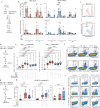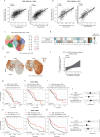Immunotherapy with conventional type-1 dendritic cells induces immune memory and limits tumor relapse
- PMID: 40204706
- PMCID: PMC11982544
- DOI: 10.1038/s41467-025-58289-1
Immunotherapy with conventional type-1 dendritic cells induces immune memory and limits tumor relapse
Abstract
The potential of dendritic cell (DC) vaccination against cancer is not fully achieved. Little is known about the precise nature of the anti-cancer immune response triggered by different natural DC subsets and their relevance in preventing postsurgical tumor recurrence. Here, we use mouse splenic conventional DC1s (cDC1s) or cDC2s pulsed with tumor cell lysates to generate DC vaccines. cDC1-based vaccination induces a stronger effector and memory CD4+ and CD8+ anti-tumor T cell response, leading to a better control of tumors treated either therapeutically or prophylactically. Using an experimental model of tumor relapse, we show that adjuvant or neoadjuvant cDC1 vaccination improves anti-tumor immune memory, particularly by increasing the infiltrates of CD4+ tissue resident memory (Trm) and CD8+ memory T cells. This translates into complete prevention of tumor relapses. Moreover, elevated abundance of cDC1s positively correlates with CD4+ Trm presence, and both associate with enhanced survival in human breast cancer and melanoma. Our findings suggest that cDC1-based vaccination excels at immune memory induction and prevention of cancer recurrence.
© 2025. The Author(s).
Conflict of interest statement
Competing interests: S.K.W. serves as a consultant for ONA therapeutics (Barcelona, Spain). D.S. has a research collaboration agreement with Inmunotek SL (Alcala de Henares). I.M. reports grant funding from Roche, BMS, Astrazeneca, Genmab, and Pharmamar and advisory roles with Roche-Genentech, Bristol-Myers Squibb, Astrazeneca, F-Star, Genmab, Third Rock Ventures, Amunix Pharmaceuticals, Alligator, Bioncotech, Boston Therapeutics, Bright Peak, Numab, Catalym, Pieris, and Pharmamar. The rest of the authors declare no competing interests.
Figures







References
MeSH terms
Substances
Grants and funding
LinkOut - more resources
Full Text Sources
Medical
Molecular Biology Databases
Research Materials

